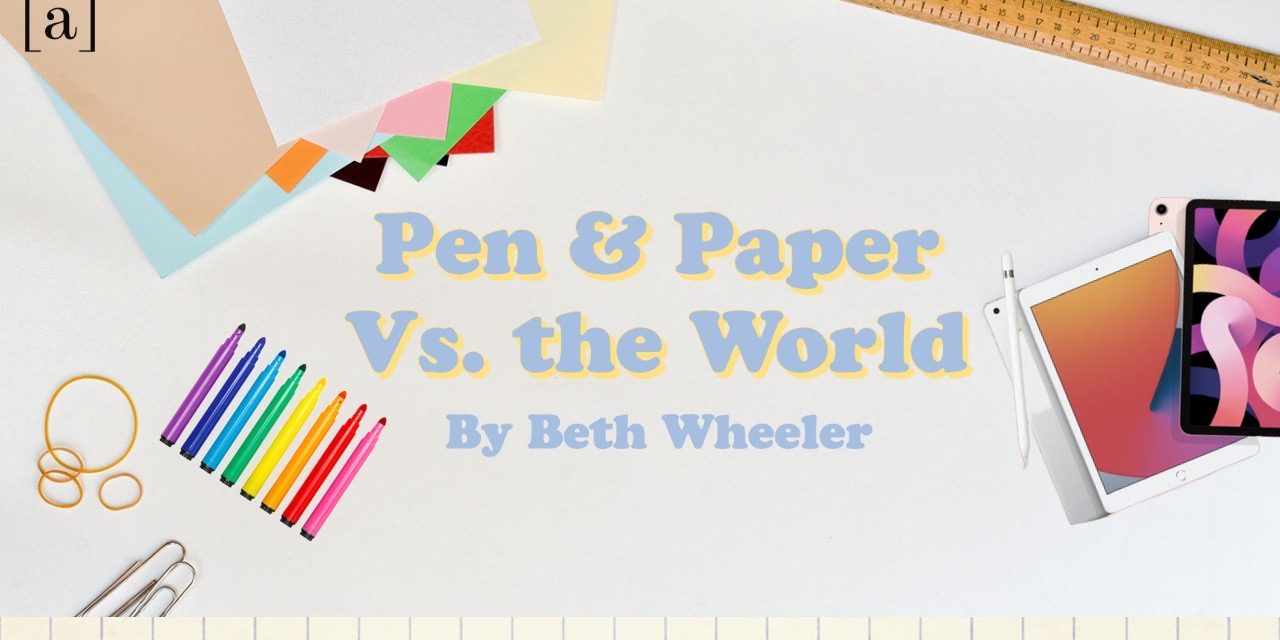Notebooks are becoming an endangered species.
Beth Wheeler | Marketing Editor
With the school year approaching quickly, stress over what supplies or electronics to use during the school year may arise. With trendier devices taking the scene, there is debate over switching from traditional pen-and-paper to the iPad. The race to keep up with the latest trends has finally seeped into the education sector.
So, what exactly are the pros and cons of using either option? Which should note-takers really be using? One of the biggest factors that many take into consideration is the price difference of the two, with the iPad costing hundreds (or even thousands) more than traditional pen and paper. However, here is a broken-down guide for the college student looking to weigh their options further.
Note Taking
The most important aspect of it all. Before the emergence of the iPad, students spent the first few weeks before school doing school shopping to stock up on their favorite binders, notebooks and folders. New colors and designs on the Five Star notebooks of the season set the mood for the year. In addition, students pick out an array of pens and pencils to write their notes, with highlighters being the cherry on top.
There have been multiple studies, according to ScienceNewsExplores, that show writing information down by hand is a key element to information retrieval, so the notebook and pen really nailed this benefit down. Additionally, the traditional notebook is a fraction of the price of the iPad, making it budget friendly and widely accessible to many. So why switch?
The iPad has taken on a craze of its own. With apps like Notability, GoodNotes and Apple Notes, there are multiple options to choose from to make notetaking fun and aesthetically pleasing. One of the big advantages is the ability to type ,record and share across multiple platforms. One important aspect to consider is in order to take notes and have an iPad feel more traditional, users must purchase the Apple Pencil as an accessory. This borderline necessary accessory adds on to the large price tag of taking notes via electronics.
Studying
The notes have been taken. How are they studied best? Traditionally, notes would be looked over on paper or made into hand-written flashcards. With the iPad, apps like Anki and Quizlet can create curated study sets that take on multiple different forms such as online tests, flashcards, matching games and many more without having to lift another finger. Other devices such as laptops and phones can also utilize these apps, but the iPad has a unique advantage in displaying information as large as the laptop yet being hand-held and easier to transport (without compromising for a small screen). So, while many may prefer taking notes by hand to further engraining the information, the iPad is perfect for the student that isn’t looking to waste any time or space.
Meetings and Everyday Tasks
Perhaps the most attractive quality of the iPad is the ability to have all the information and files at the touch of a finger. Rather than carrying around multiple notebooks, folders and stickie notes everywhere, the information is stored on apps and cloud accounts, to be accessed at any point in time. Forgot a notebook at home? No longer an issue. In an online meeting and want to screenshare data? No longer an issue. The iPad has become a machine used to condense all the daunting papers that students carry around. However, this doesn’t much apply to those who are fans of having tangibles .
The Conclusion
When it comes to the hot debate over which devices to use for the school year, it ultimately comes down to the person.
Fan of tradition and tangible items? Pen and paper are the go-to. Fan of helpful apps and good with technology? The iPad is the best option. Not only stylistic preferences, but it also comes down to monetary costs. The iPad is costly (ranging from $599 for the iPad Light to $799 for the iPad Pro) in addition to the Apple Pen, which is an additional $99. The notebook can be bought in most stores starting from$0.79.
Additionally, the iPad is a friend to the environmentalist. Not only saving space in the bookbag but also saving trees by cutting down on paper waste. According to slate.com, “By contrast, an iPad uses about 3 watts per hour, which results in the release of 0.004 pounds of carbon dioxide equivalents. That means you could take notes on an iPad for more than seven hours before surpassing the greenhouse gas emissions of a single sheet of paper.”
Whether stuck on tradition or hopping on the new technology wave, there will continue to be options, and there will continue to be a hot new item to look forward to each school year.
Beth Wheeler serves as our Marketing Editor. A rising senior from Dothan, Ala., Beth is an interior design major with minors in both criminal justice and general business. Previously, she has served as the Beauty Editor, this is her second year with Alice.





